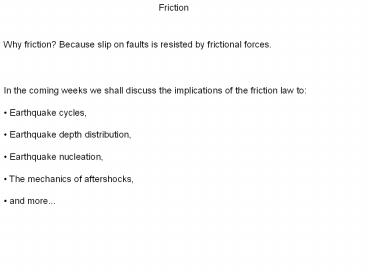Friction PowerPoint PPT Presentation
Title: Friction
1
Friction
Why friction? Because slip on faults is resisted
by frictional forces.
- In the coming weeks we shall discuss the
implications of the friction law to - Earthquake cycles,
- Earthquake depth distribution,
- Earthquake nucleation,
- The mechanics of aftershocks,
- and more...
2
Question Given that all objects shown below are
of equal mass and identical shape, in which case
the frictional force is greater?
Question Who sketched this figure?
3
Da Vinci law and the paradox
Leonardo Da Vinci (1452-1519) showed that the
friction force is independent of the geometrical
area of contact.
Movie from http//movies.nano-world.org
The paradox Intuitively one would expect the
friction force to scale proportionally to the
contact area.
4
Amontons laws
Amontons' first law The frictional force is
independent of the geometrical contact
area. Amontons' second law Friction, FS, is
proportional to the normal force, FN
Movie from http//movies.nano-world.org
5
Bowden and Tabor (1950, 1964)
A way out of Da Vincis paradox has been
suggested by Bowden and Tabor, who distinguished
between the real contact area and the geometric
contact area. The real contact area is only a
small fraction of the geometrical contact area.
Figure from Scholz, 1990
6
where p is the penetration hardness.
where s is the shear strength.
Thus
Since both p and s are material constants, so is
?.
The good news is that this explains Da Vinci and
Amontons laws. But it does not explain Byerlee
law
7
Beyrlee law
Byerlee, 1978
8
Static versus kinetic friction
The force required to start the motion of one
object relative to another is greater than the
force required to keep that object in motion.
Ohnaka (2003)
9
The law of Coulomb - is that so?
Friction is independent of sliding velocity.
Movie from http//movies.nano-world.org
10
Velocity stepping - Dieterich
Dieterich and Kilgore, 1994
- A sudden increase in the piston's velocity gives
rise to a sudden increase in the friction, and
vice versa. - The return of friction to steady-state occurs
over a characteristic sliding distance. - Steady-state friction is velocity dependent.
11
Slide-hold-slide - Dieterich
Dieterich and Kilgore, 1994
Static (or peak) friction increases with hold
time.
12
Slide-hold-slide - Dieterich
- The increase in static friction is proportional
to the logarithm of the hold duration.
Dieterich, 1972
13
Monitoring the real contact area during slip -
Dieterich and Kilgore
14
Change in true contact area with hold time -
Dieterich and Kilgore
Dieterich and Kilgore, 1994
- The dimensions of existing contacts are
increasing. - New contacts are formed.
15
Change in true contact area with hold time -
Dieterich and Kilgore
Dieterich and Kilgore, 1994
- The real contact area, and thus also the static
friction increase proportionally to the logarithm
of hold time.
16
The effect of normal stress on the true contact
area - Dieterich and Kilgore
Dieterich and Kilgore, 1994
- Upon increasing the normal stress
- The dimensions of existing contacts are
increasing. - New contacts are formed.
- Real contact area is proportional to the
logarithm of normal stress.
17
The effect of normal stress - Dieterich and Linker
- Changes in the normal stresses affect the
coefficient of friction in two ways - Instantaneous response, whose trend on a shear
stress versus shear strain curve is linear. - Delayed response, some of which is linear and
some not.
Linker and Dieterich, 1992
Instantaneous response
linear response
18
Summary of experimental result
- Static friction increases with the logarithm of
hold time. - True contact area increases with the logarithm
of hold time. - True contact area increases proportionally to
the normal load. - A sudden increase in the piston's velocity gives
rise to a sudden increase in the friction, and
vice versa. - The return of friction to steady-state occurs
over a characteristic sliding distance. - Steady-state friction is velocity dependent.
- The coefficient of friction response to changes
in the normal stresses is partly instantaneous
(linear elastic), and partly delayed (linear
followed by non-linear).
19
The constitutive law of Dieterich and Ruina
- were
- V and ? are sliding speed and contact state,
respectively. - A, B and ? are non-dimensional empirical
parameters. - Dc is a characteristic sliding distance.
- The stands for a reference value.
20
The set of constitutive equations is non-linear.
Simultaneous solution of non-linear set of
equations may be obtained numerically (but not
analytically). Yet, analytical expressions may be
derived for some special cases.
- The change in sliding speed, ?V, due to a stress
step of ?? - Steady-state friction
- Static friction following hold-time, ?thold
21
The evolution law Aging-versus-slip
Aging law (Dieterich law)
Slip law (Ruina law)
22
Slip law fits velocity-stepping better than aging
law
Linker and Dieterich, 1992
Unpublished data by Marone and Rubin
23
Aging law fits slide-hold-slide better than slip
law
Beeler et al., 1994
24
- In the coming weeks we shall discuss the
implications of the friction law to - Earthquake nucleation,
- Earthquake depth distribution,
- Earthquake cycles,
- The mechanics of aftershocks, and more.
- Recommended reading
- Marone, C., Laboratory-derived friction laws and
their applications to seismic faulting, Annu.
Rev. Earth Planet. Sci., 26 643-696, 1998. - Scholz, C. H., The mechanics of earthquakes and
faulting, New-York Cambridge Univ. Press., 439
p., 1990.

